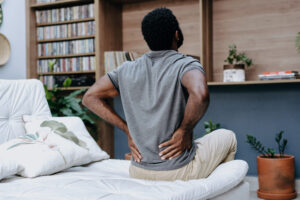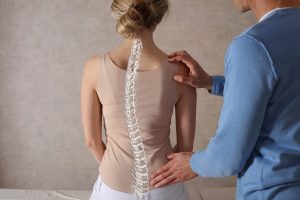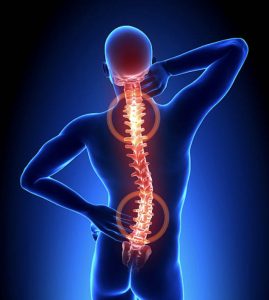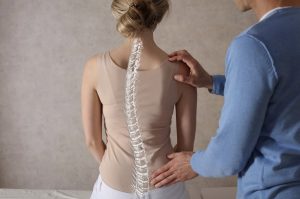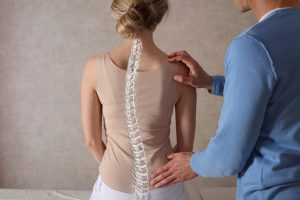Scoliosis
Of all the degenerative conditions that can take place in the spine, scoliosis is one of the more dramatic conditions that can result. Scoliosis, or the natural curvature of the spine, is known largely as a spine condition that can affect children and adolescents, but it can also develop in patients who are aging and experiencing normal deterioration of the spinal components.
Also known as adult scoliosis, this form of the condition is characterized by the formation of a sideways C or S-shaped curve in the lumbar (lower) spine and most commonly occurs in patients 65 or older. These natural curves, called lordosis and kyphosis, can develop excessive curvature due to a number of factors. If you have been diagnosed with scoliosis, or want to learn about preventative measures, allow this guide to advise you through the next steps.
Causes
The causes of scoliosis are largely unknown, though the condition can generally be categorized in a few different ways. Abnormal spinal curvature can occur in the womb if the bones of the spine form incorrectly or fuse during development, which is called congenital scoliosis. Neuromuscular scoliosis can come about if an individual develops diseases such as polio, cerebral palsy, muscular dystrophy, or atrophy of the spinal muscles. Degenerative scoliosis, also called adult scoliosis can develop in people who had scoliosis earlier in life and are now experiencing a progression of the condition, or it can also develop in adults who never had scoliosis.
Conservative Treatment Options
Treated scoliosis typically begins with conservative treatment options including nonsteroidal anti-inflammatory drugs and physical therapy. These options can help lessen the pain associated with scoliosis and strengthen your back muscles. Other conservative options include:
- Bracing
- Chiropractic treatment
- Yoga
- Medical massage
If a patient tries conservative methods for several weeks and doesn’t notice any results, they may be a candidate for surgery.
Symptoms
Scoliosis can be accompanied by a variety of painful symptoms including lower back pain, difficulty breathing, and one shoulder or hip that sits higher than the other. However, some patients with scoliosis may not experience any symptoms and will only discover the condition after receiving an X-ray, MRI, or a CT scan for another condition. This is because scoliosis, which is the excessive side-to-side curving of the spine, is not painful by itself and usually becomes symptomatic only when a nerve in the spine becomes compressed.
Symptoms may include:
- Uneven shoulders or waist
- Difficulty standing or walking
- Shortness of breath
- Bump in the lumbar spine
- Stiffness in the lower back
If you are experiencing any severe symptoms, it is important to consult with your doctor to ensure the pain does not worsen.
Diagnosis
During the diagnostic process, the doctor will likely perform a physical examination to test your reflexes and range of motion. This will allow them to pinpoint the areas and motions that cause you pain. You may also be asked to do a forward bend test which is a more specific scoliosis diagnostic technique. Finally, you and your doctor will review your medical history and family history.
After these initial tests, the doctor may issue an X-ray or MRI to confirm a scoliosis diagnosis. Diagnostic imagery like this will determine the state of your spinal curvature.
Surgical Treatment Options
Many patients decide against spinal surgery due to the long recovery times and the invasive nature. However, the medical professionals at BEST Health System are highly-skilled in specializing in minimally-invasive spine surgeries. Our minimally-invasive fusion procedures can help address the deformity caused by adult scoliosis in the lumbar spine without the need for large incisions or cutting muscles that are commonly associated with traditional open-back fusion. Instead, we remove deteriorating discs, decompress neural structures, realign vertebrae, and insert minimal stabilizing implants all through small incisions.
Reach out to BEST Health System
If you have been diagnosed with scoliosis, you should not suffer in silence. Connect with the healthcare professionals at BEST Health System and get started on your road to recovery.
Related Articles
The New Way Patients Are Finding Relief from Chronic Back Pain
Living with Chronic Back Pain Living with chronic back pain can be incredibly challenging, and can impact your life in countless ways. Chronic back pain, […]
Scoliosis Symptoms
What is Scoliosis? Scoliosis describes the abnormal curvature of the spine. The types of scoliosis symptoms that someone experiences will depend entirely on the severity […]
What is Scoliosis in the Back?
Scoliosis is the presence of an abnormal spinal curvature. This condition affects 2-3% of the population, according to the American Association of Neurological Surgeons. Scoliosis […]
Understanding the Types of Scoliosis
Scoliosis is abnormal lateral, or side-to-side, the curvature of the spine. While most people may be familiar with scoliosis being diagnosed among the adolescent population, […]
Understanding the Types of Scoliosis
Scoliosis Basics Scoliosis is abnormal lateral, or side-to-side, the curvature of the spine. While most people may be familiar with scoliosis being diagnosed among the […]
